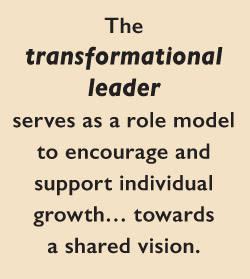What’s Your Leadership Style?
Cheryl A. Moore, PsyD
CEO, Prestige Countertops & Services
 If you were asked to explain the difference between a manager and a leader, how would you answer this question?
If you were asked to explain the difference between a manager and a leader, how would you answer this question?
When you look at yourself and the role you play in your organization, do you perform as a manager or as a leader? If you are a leader, how would you describe your leadership style? These are all questions you may not consciously sit back and think about, but are worth consideration.
In most organizations there are typically four different processes taking place simultaneously: individual, team, organizational, and influences. Influences is the leadership team of the organization and is the bridge between the other three processes and organizational outcomes like individual and team performance, job satisfaction, and organizational goals. Given the importance and impact of a leadership role, this month I will address the opening questions and define a few of the many leadership approaches and theories that are present in today’s organizations.
Leaders and managers have similarities in the roles they perform in as much as they both work with people, set goals, and influence others. Leaders differ from managers, however, by looking at the big picture as it relates to organizational objectives and setting long-term goals. A leader is a visionary and acts as a role model to inspire followers towards the organizational mission and goals. Managers set short-term goals and expectations for their subordinates. The manager trains and develops employees in his or her area to ensure that the operations of that department run smoothly. A manager is engaged in and responsible for the daily operations of the organization. While it can be helpful for a leader to understand the operational duties of the manager or to have background knowledge in management, it is not required to be a good leader. Not all managers are good leaders, just as all leaders are not good managers.
Early leadership perspectives suggested that great leaders like Lincoln and Churchill were born, not made. It was believed that great leaders had to possess certain personal qualities and characteristics to be a great leader. While other researchers were skeptical of this thought, they did believe that great leaders possess certain traits that can be nurtured and developed to create great leaders.
As leadership theories continued to progress, it was suggested that individuals possess specific behaviors to be a good leader. These behaviors included actions like defining roles for employees, setting clear guidelines and procedures, demonstrating and developing mutual trust and respect, and building on interpersonal relationships. Current researchers have built on all these past perspectives and used them to explain how leaders should motivate and build relationships with followers to achieve performance.
The aforementioned leadership perspectives – trait-based, skills-based, and behavioral-based – are all used today. Individuals have their own leadership style that incorporates these perspectives with the situation and individual leader. Four of the most common leadership styles I would like to present here are the transactional leader, the laissez-fair leader, the transformational leader, and the charismatic leader.
The transactional leader is most closely related to management in that it relates to routine regimented activities. The transactional leader assumes that employees are motivated by goals and equitable rewards. This is an exchange process in which the transactional leader provides the task at hand and the follower completes the task for a reward. This can range from the department manager providing the schedule for the day to meet required production levels, to a coach heading a sports team to compete for a win. The transactional leader sets clear and objective goals for the followers and motivates through rewards and punishments.
This type of leadership discourages creativity and eliminates individuality. It can be difficult for the leader to find a reward that would motivate everyone. Since the transaction is based on reward for performance, if the results are not achieved, there is more focus on consequences than rewards. This leadership style maintains the status quo and works within an existing organizational culture rather than working toward change.
The laissez-fair leader uses a hands-off approach. The laissez-fair leader delegates responsibilities to others and is only hands-on when needed. While this type of leadership can encourage innovation and personal growth, it also has the negative connotation that the leader doesn’t care what is going on with his or her team. Employees with this type of leadership can be less motivated and lack role clarity. It can be harder to reach cohesion in teams with this leadership style and employees who have low autonomy would struggle in their position.
 The transformational leader serves as a role model to encourage and support individual growth within his or her followers, towards a shared vision to meet the goals and objectives of the organization. This type of leader encourages goal-setting, creativity, and innovation in problem-solving. The leader collaborates with the followers to implement new initiatives and work toward changing organizational culture. The four dimensions of transformational leadership are idealized influence, inspirational motivation, intellectual stimulation, and individualized consideration. Through the behaviors of this leadership style, the leader gains the trust, admiration, and respect of the followers. A disadvantage of this leadership style is that of a pseudo-transformational leader. A leader can possess these behaviors and qualities but use them for personal gain rather than the organization as a whole. When the pseudo-transformational leader sees no value in helping others to reach his or her own personal agenda, the leader’s true intentions will come through.
The transformational leader serves as a role model to encourage and support individual growth within his or her followers, towards a shared vision to meet the goals and objectives of the organization. This type of leader encourages goal-setting, creativity, and innovation in problem-solving. The leader collaborates with the followers to implement new initiatives and work toward changing organizational culture. The four dimensions of transformational leadership are idealized influence, inspirational motivation, intellectual stimulation, and individualized consideration. Through the behaviors of this leadership style, the leader gains the trust, admiration, and respect of the followers. A disadvantage of this leadership style is that of a pseudo-transformational leader. A leader can possess these behaviors and qualities but use them for personal gain rather than the organization as a whole. When the pseudo-transformational leader sees no value in helping others to reach his or her own personal agenda, the leader’s true intentions will come through.
So, which leadership style is yours? The purpose of this article was to present some leadership theories and styles in an effort for you to recognize yours. Resonating with a particular style enables you to consider the advantages and disadvantages of each one. It has been shown in this article that there are different traits, skills, behaviors, and situations that warrant different leadership styles. There may be situations where both a transactional and transformational style of leadership can be most effective. If you are a business owner, what style do you recognize in your leaders? Are your leaders leading in a way that motivates and inspires employees to work with others to obtain the goals and objectives of your organization? Are your leaders encouraging their subordinates to grow and be innovative in both their personal goals, as well as those of the organization? If you and your leadership team are not actively having conversations on long-term strategic planning and what you are going to do to grow, you will remain stagnant as an organization.
Cheryl is the CEO of Prestige Countertops & Services, Inc.
Contact her at cmoore2@mercyhurst.edu .